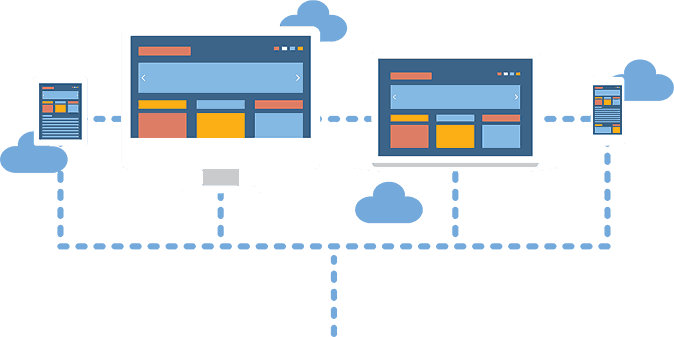The outsourced IT services market is worth about $400 billion globally according to a recent study by Capital Counselor news. About 70% of survey respondents say the number one reason they are outsourcing IT is cost reduction, according to the study. But there are other benefits. In this post we will list the top IT outsourcing pros and cons, but first let’s start with a definition.
What is Outsourced IT
Outsourced IT is when an organization uses a third-party service provider to deliver technology related processes, applications and infrastructure solutions. Most businesses use some kind of IT outsourcing. An example of IT outsourcing services may be a business that develops custom apps and services for other businesses. Other processes that are commonly outsourced include:
Web development and hosting
Help desk support
Application support or management
Database development and management
Outsourcing IT Pros and Cons
We will look at these pros and cons in detail, but first, here’s a quick snapshot.
PROS | CONS |
|
|
Related: Virtual Organization Structure for a Remote Business
Outsourced IT Pros
1. Cost-effective: In many cases, outsourcing IT services presents cost savings. For example, taking advantage of the providers hardware and other infrastructure can help save on the upfront expense of building new IT processes.
2. Better access to broader talent pool: Because you are relying on your providers’ talent pool you not only have access to various teams, you gain more flexibility in your own IT hiring strategy. Let’s say you outsource customer technical support, you have more space on your own team to hire internal support, for example
3. Better access to state of the art technology: It’s common for many companies to rely on the same server or the same piece of software for 5-plus years, or more than a decade in some cases. For technology service providers on the other hand, being at the forefront of technology is key to their mission. Outsourcing let’s you take advantage of this without having to invest yourself.
4. Internal IT has more time to focus on serving the business: With some of your IT process outsourced, you can focus your internal IT strategy on what matters most to your business, whether it’s serving internal support needs or innovating customer experience technology.
Outsourced IT Cons
1. Less accountability compared to in-house: While many technology service businesses hold accountability to their customers as a core value, nothing beats being able knock on someone’s door or call their direct line where accountability is concerned.
2. Less control over infrastructure: While providers can tailor much of their services to your needs, they also have internal policies and continuity requirements they have to meet. This can create some rigidity from the client’s perspective. When choosing providers it’s good to pick a firm whose policies match your needs.
3. Lack of communication compared to in-house IT: Similar to our first con. Many tech firms are great at being reachable, but nothing beats a direct line of communication.
4. Negative on Employee Morale: Sometimes your internal IT team can see outsourcing as a threat or insult. This is less common these days as most IT shops are accustomed to and even driving outsourcing initiatives.
5. Less Flexibility: Like we said in our second con, providers likely offer enough flexibility for most use-cases, but you are still working within 3rd party policies.
[vc_row][vc_column width=’1/4′][/vc_column][vc_column width=’1/2′]
Simplify Your Path to Secure Cloud

CyberlinkASP’s Virtual Desktop Hosting and Application Delivery Service provides secure, affordable, and scalable cloud hosting.
[/vc_column][vc_column width=’1/4′][/vc_column][/vc_row]
How to Choose IT Outsourcing Services
When it comes to choosing IT services of any kind, choosing the right provider is the key. Spending more time on vendor selection is the #1 priority for improving practices around outsourced IT services, according to a 2020 survey from Deloitte.
“The industry is trying to address two competing needs: getting the details right and the need for speed,” said Deloitte. “With new, disruptive solutions in the market, the task of systematically selecting providers is increasingly complex, requiring long RFP processes with providers to craft customized solutions. But the need to get the details right runs counter to the need for speed, since one of the most important design principles in a rapidly changing business environment is to outpace competitors.”
Here are the top considerations when choosing an outsourced IT provider.
Vendor Reputation: Does the provider have a high customer retention rate? Do clients offer testimonials?
Vendor History: How long has the provider been in business? How long have they been providing the service you are considering? Do they have a history of working in your industry?
Service Levels: Does the vendor offer a service level contract that meets your uptime and compliance requirements?
Financial Security: Does the vendor provide financial statements or a financial report to prove they are fiscally stable?
Distribution of Resources: Where are the provider’s data centers and employees?
You May Also Like: What is a Hosted App?
Using IT Outsourcing Wisely
Outsourcing IT functions is commonplace now. In fact, it would be surprising if the company you own or work for isn’t already outsourcing at least part of its IT processes. Here is our key take away: Using outsourced IT services wisely is no longer a question of should you do it, but a question of what to outsource and how much to outsource.

